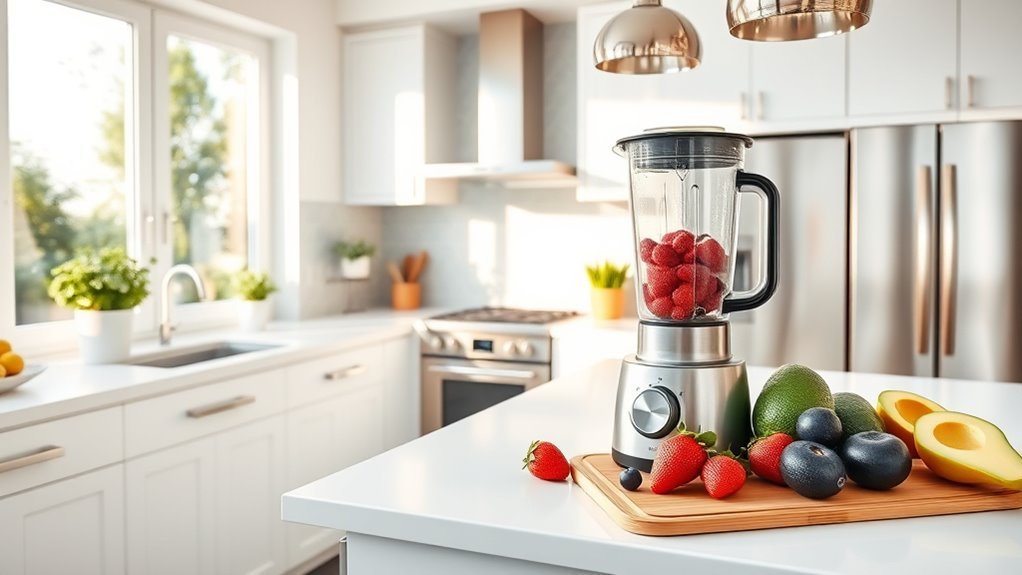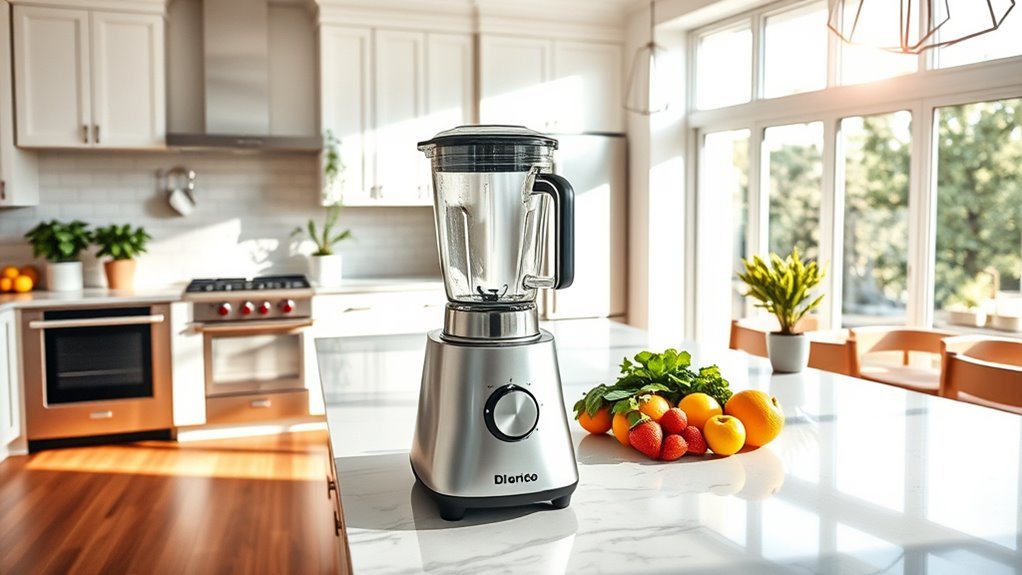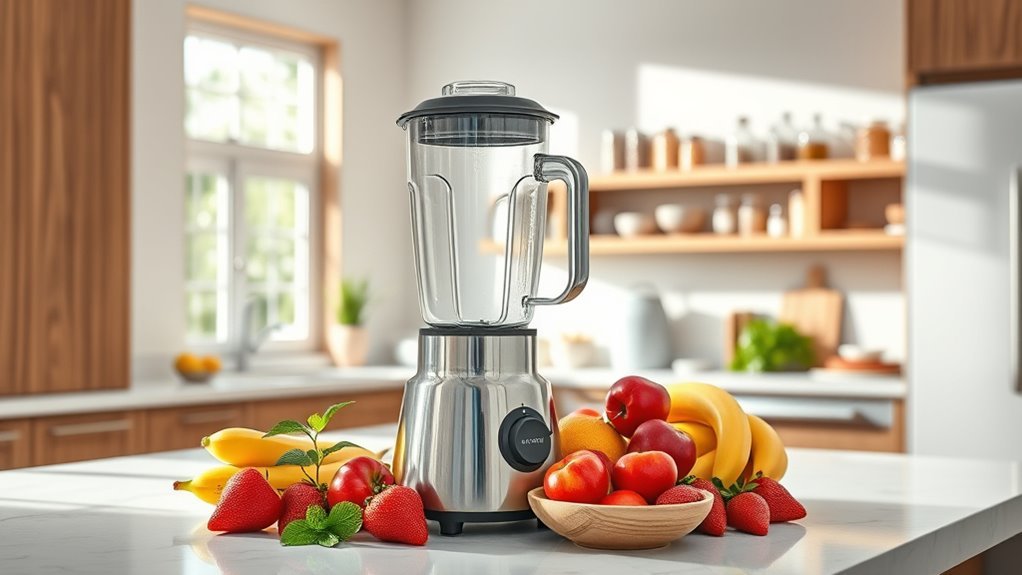We’ve found blender blades last longer when three key elements align: premium materials, smart engineering, and proper maintenance. High-grade stainless steel construction and sophisticated heat treatment create durable blades that resist wear. Thicker gauges and serrated edges handle tough ingredients without dulling. Regular cleaning with warm, soapy water prevents residue buildup and corrosion. But there’s more to maximizing your blade’s lifespan than just quality materials and basic care.
Quality Factors in Blade Construction

While many blender owners focus on motor power, it’s the blade construction that makes or breaks your blending experience.
Let’s get real about what separates lasting blades from disposable ones.
First up: material quality. We’re looking at high-grade stainless steel – not that flimsy stuff in bargain blenders. Premium blade technology isn’t just marketing hype; it’s about sophisticated heat treatment processes that boost hardness and durability.
When we examine top-tier brands like Vitamix, we’re seeing thicker blades with protective coatings that laugh in the face of rust and wear. Additionally, high-performance blenders often feature sharper and more robust blades designed for optimal performance.
The engineering matters too. Blade thickness and shape aren’t random choices – they’re calculated decisions that determine whether your blender conquers ice or surrenders to carrots.
Trust us, that extra investment in quality pays off in years of reliable performance.
Impact of Regular Maintenance
Since your blender’s blades face constant abuse from ice, fibrous greens, and frozen fruit, proper maintenance isn’t optional – it’s survival.
We’re not messing around here: consistent maintenance will double or triple your blade life. After each blend, hit those blades with warm, soapy water – no excuses. You’ll prevent that nasty residue buildup that turns sharp edges into dull paperweights.
Don’t forget the gasket; replace it regularly unless you enjoy cleaning smoothie splatters off your ceiling.
Here’s your power move: inspect those blades monthly. See rust? Attack it. Blades looking tired? Sharpen them. When they’re beyond help, replace them immediately.
We’re not running a retirement home for worn-out hardware. Smart maintenance now means fewer replacements later – simple as that. Remember, high-performance blenders require more attention due to their powerful motors and the tough ingredients they handle.
Design Elements That Enhance Longevity

When it comes to blade longevity, design makes all the difference – and we’re not just talking about looks.
We’ve found that high-quality stainless steel construction is non-negotiable, offering superior rust and corrosion resistance. But there’s more to it.
Let’s break the blade assembly apart to examine critical design elements. Thicker gauge blades withstand daily abuse better, while serrated edges tackle tough ingredients without dulling.
We’re particularly adamant about full-tang construction – it’s not just fancy terminology, it’s engineering that matters. The blade extends through the entire handle, delivering balance and strength you can count on.
Don’t overlook removable blades – they’re game-changers for maintenance. When you can easily access blades for cleaning and sharpening, you’re investing in longevity.
Proper Usage and Wear Prevention
Although proper blade maintenance starts with smart usage habits, it’s your daily decisions that truly determine blade longevity.
We’ve found that selecting appropriate speeds for different blending tasks prevents unnecessary strain, while avoiding hard ingredients like ice (unless absolutely necessary) reduces wear.
Let’s focus on proper usage – frozen fruits are gentler on blades than ice, and following manufacturer-recommended blending times prevents overheating damage.
For effective wear prevention, we’ll insist you clean those blades thoroughly after each use.
Food residue isn’t just gross – it leads to corrosion that kills blade performance.
And don’t forget regular sharpening when needed.
Trust us, these simple preventive measures make the difference between blades that last years and those that give up after months.
Signs of Blade Performance Decline

Blender blade deterioration reveals itself through unmistakable warning signs that smart users won’t ignore.
When we’re noticing our blender taking longer to process ingredients or struggling to achieve that perfect puree, it’s time to pay attention – these are classic signs of blade performance decline.
You’ll know something’s wrong when the motor starts screaming louder than usual during blending sessions.
We’re also talking about blades that feel stiff or won’t rotate smoothly – that’s your cue for potential bearing problems.
And here’s a dead giveaway: if you’re seeing brown or discolored liquid after blending, those blades might be rusting.
Letting these issues slide isn’t just about subpar smoothies – it’s a fast track to burning out your motor and shortening your blender’s life.
Optimal Storage and Handling Methods
Since proper storage directly impacts blade life, let’s get serious about protecting our investment. Ideal storage starts with keeping the blender upright – this isn’t just neat-freak advice, it’s essential for preventing blade damage and spills.
We’re not done yet. Keep your blender away from heat sources (yes, that means not next to the stove), and don’t let other kitchen items play stack-a-mole on top of it. The motor and blades will thank you.
For handling best practices, treat your blender like the precision instrument it is. Use those protective covers – they’re not just decorative – and maintain a dust-free environment.
When cleaning, remember: gentle but thorough is the name of the game. One accidental drop can turn sharp blades into dull paperweights.
Frequently Asked Questions
What Is the Average Lifespan of a Blender?
Time tells all tales. We’ve found blenders typically last 5-10 years, though with proper blender maintenance tips and quality blade material comparison, you’ll get more mileage from high-end models.
How Often Should You Replace a Blender Blade?
We should replace blender blades every 5-10 years, but blade material differences affect longevity. With proper blade maintenance tips like regular cleaning and careful use, they’ll last toward the longer end.
Do Eggshells Actually Sharpen Blender Blades?
Ever wondered about those eggshell benefits? While they can provide mild abrasive cleaning, we don’t recommend using them for blade maintenance – they’re more likely to cause wear than actual sharpening.
Why Are Vitamix Blades Not Sharp?
We’ll find Vitamix blades aren’t sharp by design – they’re intentionally blunt for better blender maintenance and durability. The blade design creates powerful vortex action that pulverizes ingredients efficiently.

